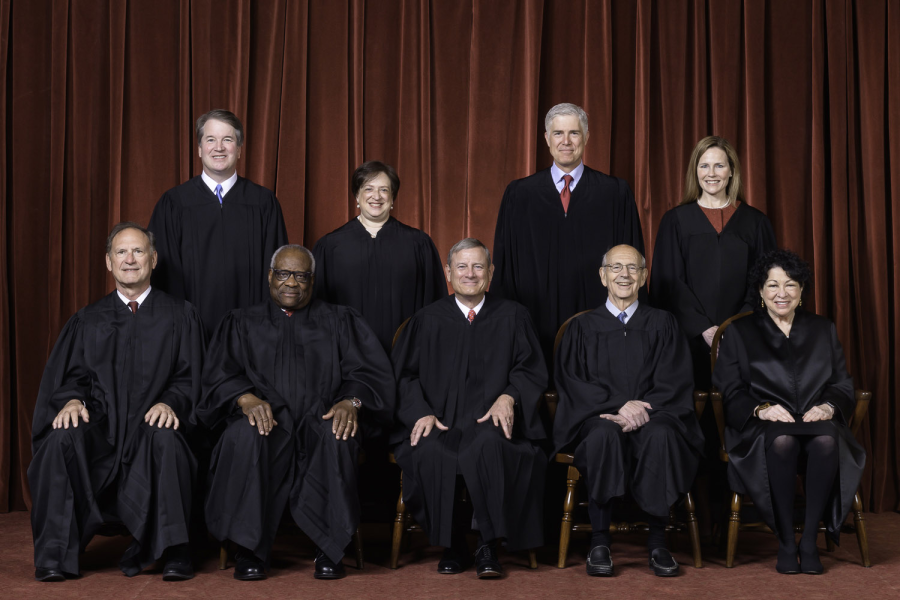Update on the Supreme Court
January 21, 2022
The Supreme Court has recently drawn the attention of many, amidst various controversial cases that it has agreed to hear. Therefore, I thought that it would be a fitting time to give an overview of the Supreme Court and discuss some of its recent and upcoming cases.
When looking at the structure of the Supreme Court, many split the Justices into three groups of three. The most conservative justices tend to be Clarence Thomas, Samuel Alito, and Neil Gorsuch, while the liberal side of the court consists of Sonia Sotomayor, Elena Kagan, and Stephen Breyer. The third group is the “center” of the court, which includes Amy Coney Barrett, Brett Kavanaugh, and John Roberts. However, the justices in the center tend to lean conservative on most issues. The reason that many consider them to be in the center of the court, is that Barrett and Kavanaugh are relatively new members of the group, and have not made enough rulings to cement their position on the ideological spectrum. With this being said, the general consensus is that the conservatives hold a 6-3 majority on the Supreme Court. However, it is not entirely uncommon for a conservative justice to vote with the other side, and vice versa.
One case that was recently brought to attention was a Mississippi abortion law. This law states that abortions in Mississippi will be made illegal after 15 weeks of pregnancy. However, prior cases ruled upon by the Supreme Court, including Roe v. Wade and Planned Parenthood v. Casey, state that abortions must take place before the stage of fetal viability, which occurs around 24 weeks into the pregnancy. Therefore, the law was challenged and eventually made its way to the Supreme Court. This case gained so much attention because it allows the Supreme Court to overrule Roe v. Wade or Planned Parenthood v. Casey, both major cases in American law. Many believe an overruling to be quite feasible, due to the balance of the court. As mentioned before, the conservatives generally hold a majority on the court, making it quite possible to overturn these precedents. At the oral arguments for the Mississippi law, held in December, Justice Gorsuch seemed to favor overturning Roe v. Wade, and it is safe to assume the same for Justices Thomas and Alito, given their past records. Justices Barrett and Kavanaugh did not seem opposed to overruling Roe at the oral arguments, although they did keep their cards close to their chest. Justice Roberts seems to want to take a middle path, and not overturn Roe, but move the legal deadline for abortion to 15 weeks and thus remove the fetal viability standard (which is around 24 weeks). Therefore, if Barrett and Kavanaugh decide to vote with the conservatives, they would have the 5 votes needed to overturn Roe v. Wade. It is also important to note that if Roe v. Wade were overturned, this does not mean that abortion would be illegal in the United States. It would simply be left up to the states to make their own laws regarding the topic. The court will make its ruling sometime around May or June, so it will be interesting to see its possibly historic decision.
I hope this overview was helpful in deciphering what all the buzz has been around the Supreme Court recently. It will be interesting to see the court’s future rulings, especially relating to the Mississippi law, and if Justices Kavanaugh and Barrett will move further to the conservative side of the court, or remain in the center.
Another important case that was recently handled by the Supreme Court was the OSHA (Occupational Safety and Health Administration) and CMS (Centers for Medicare and Medicaid Services) vaccine mandates. The OSHA vaccine mandate, brought about by the Biden administration, would have required all employees at a business with 100 or more workers to get vaccinated or to submit a negative COVID test weekly. This mandate was struck down by the Supreme Court, in a 6-3 ruling, as it was deemed that OSHA did not have the power to enact such a mandate. Justices Kagan, Sotomayor, and Breyer dissent. However, the CMS mandate, which would require healthcare workers to be vaccinated, was allowed by the Supreme Court in a 5-4 decision. This time, Justices Kavanaugh and Roberts joined the liberal side of the court, voting to uphold the mandate.
